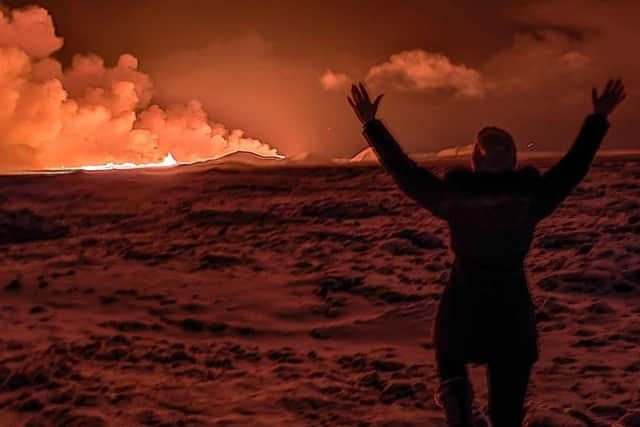Iceland volcano: Volcano erupts on Icelandic peninsula - what will this mean for travellers?
A long-expected volcanic eruption in Iceland has finally begun, over a month after more than 1,000 residents were evacuated from their homes amid a flurry of seismic activity.
Lava is pouring from a two mile-long crack in the earth’s surface near the town of Grindavik, in a more powerful eruption than others which have occurred on the Reykjanes peninsula in the past three years.
Advertisement
Hide AdAdvertisement
Hide AdVidir Reynisson, head of Iceland’s civil protection and emergency management, told the Icelandic public broadcaster RUV: “The magma flow seems to be at least a hundred cubic meters per second, maybe more. So this would be considered a big eruption in this area at least.”


In November, police evacuated the town of Grindavik after strong seismic activity in the area damaged homes and raised fears of an imminent eruption.
The eruption occurred shortly after 10pm on Monday night following a “swarm” of earthquakes.
It came as something of a surprise to local authorities, which had said just hours earlier that, pending a final risk assessment, residents of Grindavik may be allowed to return home in time for Christmas.
For the past two weeks, residents have been allowed to enter Grindavík between 7am and 9am, but were not allowed to stay overnight. The area has been fully evacuated again since the volcanic eruption.
The Blue Lagoon, Iceland’s biggest tourist attraction, closed again on Tuesday, just days after it partially reopened following almost a month of being shuttered due to the evacuation.
In a statement, the attraction said: “A volcanic eruption commenced in Sundhnúkagígar on the evening of December 18. As a result, we have temporarily closed our facilities in Svartsengi. All guests with confirmed bookings in the upcoming days will be contacted.
“We will continue to monitor the progress and maintain close communication with the authorities, prioritizing safety and well-being. Sundhnúkagígar is a known volcanic area east of Blue Lagoon and north of Grindavík.”
Advertisement
Hide AdAdvertisement
Hide AdIceland sits above a volcanic hot spot in the North Atlantic and averages an eruption every four to five years.
The most disruptive in recent times was the 2010 eruption of the Eyjafjallajokull volcano, which spewed huge clouds of ash into the atmosphere and grounded flights across Europe for days because of fears ash could damage airplane engines.
Iceland’s foreign minister Bjarne Benediktsson said on X there were “no disruptions to flights to and from Iceland and international flight corridors remain open”.
Dr Evgenia Ilyinskaya, associate professor of volcanology at Leeds University, told the BBC there would not be the same level of disruption as 2010, with the volcanoes in south-west Iceland "physically not able to generate the same ash clouds".
Olafur Ragnar Grimsson, former president of Iceland and chair of the Arctic Circle network, separately posted on social media: “Came all of a sudden. The speed of the lava flow extremely fast. What we Icelanders call ‘a tourist eruption’. To watch. Not fear!”
The eruption could reportedly be seen from Reykjavik – about 30 miles away – with Hallgrimur Indrioason, a reporter for the state-owned Icelandic National Broadcasting Service (RUV), describing the view as "quite spectacular".
Comments
Want to join the conversation? Please or to comment on this article.
